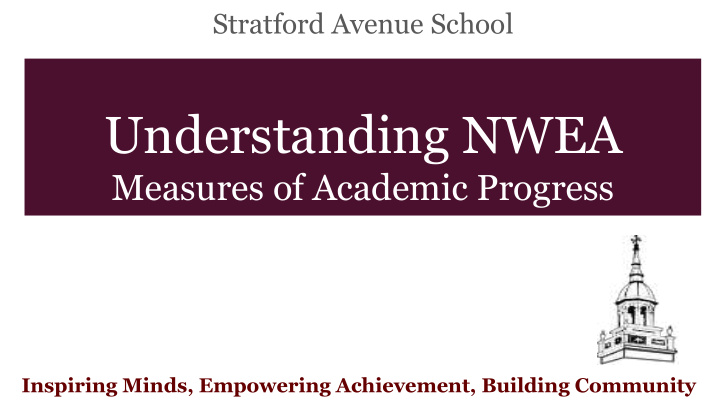



Stratford Avenue School Understanding NWEA Measures of Academic Progress Inspiring Minds, Empowering Achievement, Building Community
What is MAP? • MAP (Measures of Academic Progress) are achievement tests delivered by computer to students • Each test takes 35-60 minutes • In Mathematics, Reading, and Language Use
The Who, What, and When of MAP • The 2017 - 2018 is a pilot year for implementation • Grades 2-5 • Math, Reading and Language usage • 3 times per year
What is a computer adaptive test? • The difficulty of the test adjusts to the students’ performance. As they answer correctly, the questions become harder. As they answer incorrectly, the questions become easier. • It will build a test unique to each student. • Student results within 48 hours
What does the assessment look like? Let’s experience some sample questions together Types of Questions Sample Math Questions Sample Reading Questions https://warmup.nwea.org/warmup_start_educators_map.html
Understanding the Results -RIT ● A RIT Score is a growth measurement, similar to a reading level, it measures academic achievement over time. ● Results help teachers to… ○ Individualize instruction ○ Set achievement goals ○ Understand academic patterns in students ● Results are norm-referenced
Understanding Norm Referenced and Growth Models Norm Referenced ● Norms from NWEA are typically released every 4 years. Currently, the data is referenced from 2015 ● NWEA performs studies to collect data in grades K-11 ● Each sample size is comprised of 72,000-115,000 (varying by subject) from approximately 1,000 schools. ● These samples were drawn from test record pools of 10.2 million students attending more than 23,500 schools spread over 6,000 districts in 49 states.
Understanding Projected Growth ● Average (mean) projected growth can vary from 16 points to 4 points for 2nd graders to 5th graders ● Typically younger students demonstrate more growth ○ For example, an average growth rate from beginning to end of year in math for a second grader is 15.2 ○ For example, an average growth rate from beginning to end of year in math for a fifth grader is 9.9
Accessing Student Grade Level Norms Click Here To Access This Table
Accessing Student Growth Norms Click Here To Access This Table
Individual Student Reports
Will the scores be shared with parents? We are in the piloting phase of this assessment program Historically, benchmark assessments used to drive instruction have not been sent home The validity of the data as a measurement of growth can’t be assessed or analyzed until students complete this first year of testing.
How can I support my child? 1.Maintain your strong relationship with your child’s teacher. 2. Goal setting - Use the RIT score to discuss with your child as an important partner in the conversation about goal setting. 3. Encourage your child to read, read and read. http://www.nea.org/grants/facts-about-childre ns-literacy.html
Resources for Parents Parent Toolkit- RAZ kids - https://www.nwea.org/parent-toolkit/ https://www.raz-kids.com/ Q & A Reference Sheet- Scholastic - http://www.scholastic.com/parents/ On Stratford’s website books-and-reading/book-lists-and-re Mobymax - commendations/ages-8-10 Khan academy - https://www.mobymax.com/signin https://www.khanacademy.org/
Recommend
More recommend